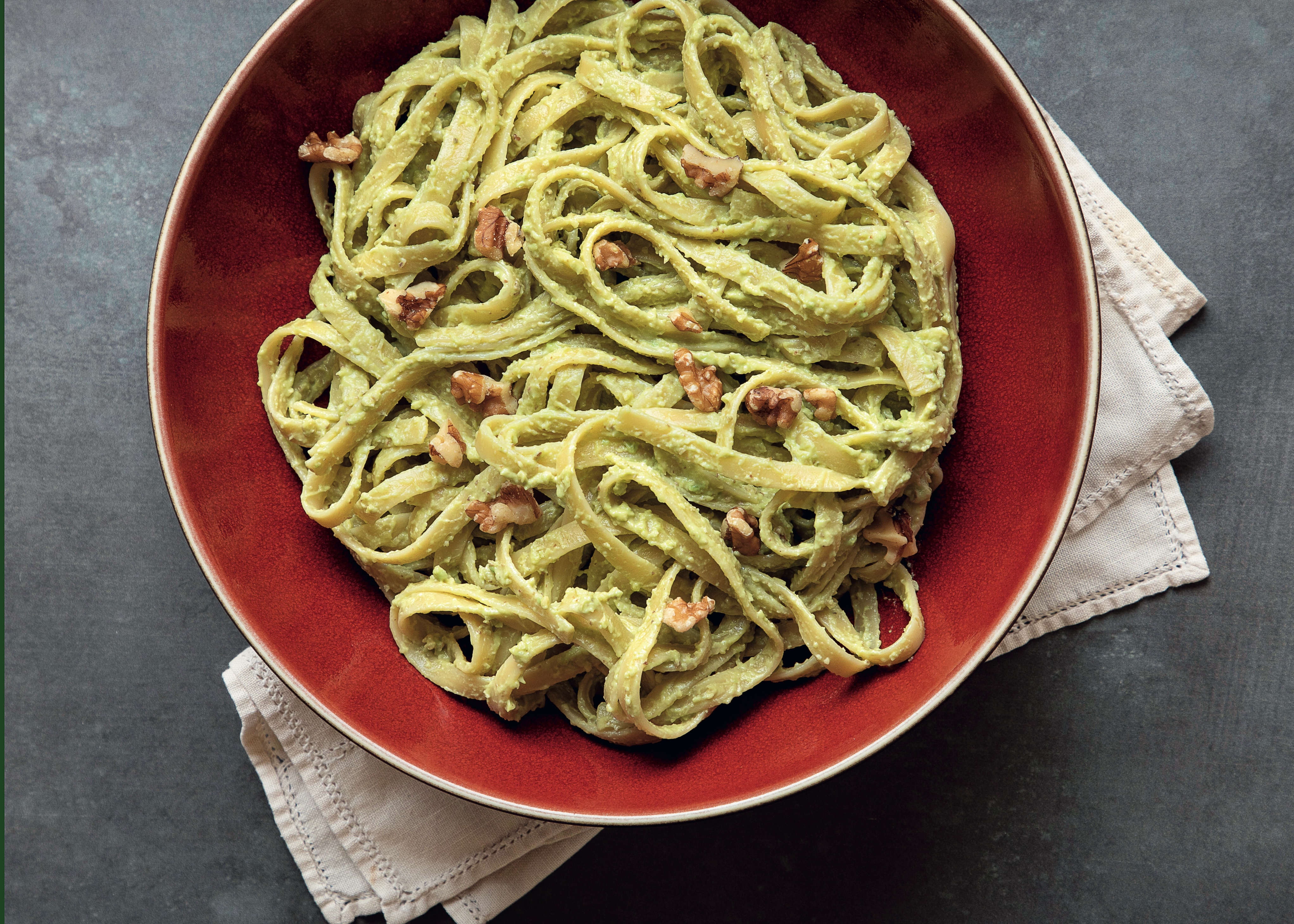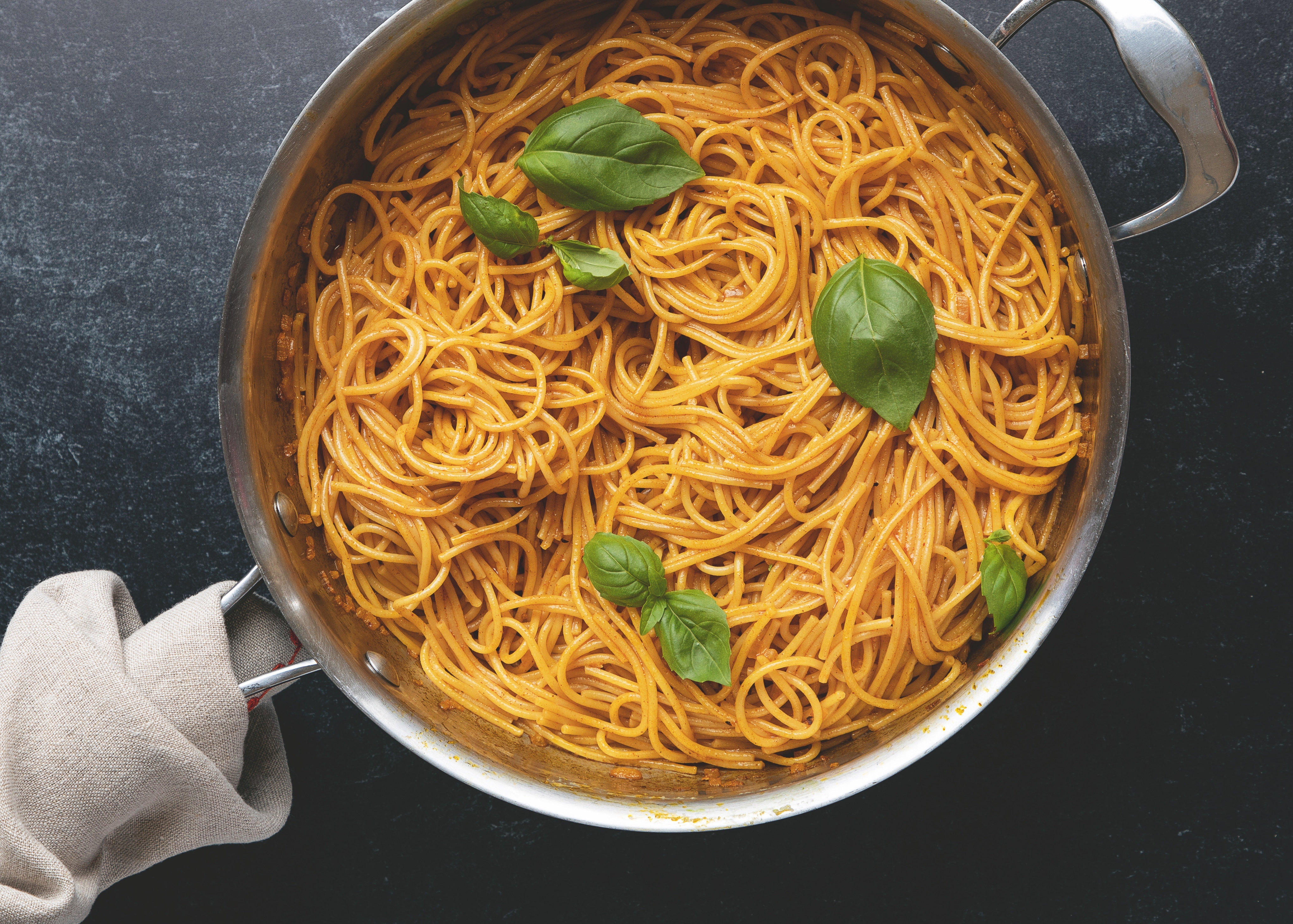For award-winning cookbook author and food historian Sandra A. Gutierrez, pasta is a lesson in Latin American history, a rich tale of resourcefulness, ingenuity and the culinary effects of colonization and immigration. Her newest book, “Latinísimo: Home Recipes from the Twenty-One Countries of Latin America,” is sweeping in scope, yet utterly approachable, with a focus on the day-to-day home cooking of all 21 nations.
Latin American pastas typically have longer and more diverse ingredient lists than their Italian counterparts, and feature ingredients like soy sauce, evaporated milk, avocado and chili paste, as well as techniques from Spain, China and Italy. It’s all anchored by a foundation of indigenous ingredients and traditions, for a cuisine that represents what Sandra calls “the true melting pot.”
You can join Sandra on January 16 at Milk Street Cooking School for a class that will take you on a journey through the continent with three unique pasta dishes, but she was kind enough to hop on the phone for an in-depth discussion about the cultural influences and ingredients that make Latin American pasta delicious but accessible, obliterating the notion that the only “authentic” pasta dishes are Italian.
Tell me a little about the history of pasta in Latin America
The first time that pasta arrives, it arrives with the Spaniards, who had gotten it from the Persians and the Muslims—the Moors, actually. It arrives with them in the 16th century more or less, early on. It doesn't become that popular until later on, when wheat is grown in the Americas, around the middle of the 16th century.
The Spaniards come first. Then the Chinese come in the 1800s, the early part of the 19th century, and they start going to places like Peru and part of Brazil and part of Mexico, and they actually do the same kind of work that they were doing in California around that time—building roads and railroads and things like that. That's what brings them over.
And around the end of the 19th century, and the beginning of the 20th century, is when the large influx of Italian immigrants arrive from Europe. And they bring another big influence—the biggest—they make the biggest splash with pasta in Latin America. The reason I mention all three cultures is that the three different cultures brought the three different ways in which Latin Americans mostly cook pasta.
What are the those ways?

So, the Spanish, from the Moors and the Persian tradition, bring sofreír, or frying a pasta until golden before you add anything to it. It's like a pilaf. The same method that you would do with rice, they do with pasta. You sauté the pasta in oil, could be lard, but the idea is you sauté it first until golden and then you add the sauce to it. That would be the first interpretation. With the arrival of the Spaniards, another very important ingredient in pasta is added to the equation and that's corn. It used to only be made with wheat.
The second interpretation that is used a lot in Latin America is the Asian interpretation. Two things: One of them is cooking it in a stir fry, so cooking it first and then stir frying it and adding other ingredients to it. The other one is to toast it slightly and then finish cooking it and add ingredients to it—the use of soy sauce, the use of fermented ingredients and of course all of the additional ingredients that come with Asian cuisine. We also get the use of rice noodles as opposed to only wheat noodles.
Now Italians bring all of the stuffed pastas, which they have been making since the Roman times. I think the very first Europeans to eat pasta were the Greeks and the Romans, who of course got it from Asia, because pasta is native to China. But while the Greeks became experts at boiling the pasta, the Italians became experts at stuffing it before they cooked it. They bring that tradition of stuffed pastas and shaped pastas when they arrive to the Americas.
Latin Americans have throughout time interpreted all of these different techniques and different ways of making pasta in different manners depending on where you are.
What are some of the ways Latin American pastas differ from Italian?
Contrary to Italians, Latin Americans love to over-sauce their pasta. There is a saying that goes, “How do you know an Argentinian from an Italian? Well, the Argentinian over-sauces their pasta.” So you usually have some sauce left on your plate. In Mexico and Peru—in some other countries, too—but mostly Mexico and Peru, after they toast the pasta, they add a sauce to it. That's the first pasta that's cooked in the same pot—the one-pot pasta. Everybody thinks that the one-pot pasta recipes are 20th century. They're not. They actually go back to the 1600s.
“Everybody thinks that the one-pot pasta recipes are 20th century. They're not. They actually go back to the 1600s.”
Italians bring traditional sauces, but it's very different. Latin American-Italian pasta is very different from American-Italian pasta. For instance, you will not find Alfredo sauce in the tradition of pasta-making in Latin America, you will not find spaghetti and meatballs. Now you do, in modern Latin America, but that's not one of the traditional ways in which they cook. They went back to more simple, more rustic [methods] and using the ingredients that you had at hand.
So yes, tomato sauces, of course—they actually originated here in the Americas, but that was before even the Italians arrived. But we do use a lot of tomato sauces. But also, even though we use cream-based sauces, it's not as simple as an Alfredo sauce. Latin Americans love to add a lot of ingredients to their creamy sauces. So mushrooms, bacon, peas—you'll find more complete, let's say more contrived, more filling recipes that use a lot more ingredients. And that is because pasta is a great way in which Latin Americans were able to stretch any other ingredients that they had leftover.
The pasta Caruso [I’ll be teaching in my class] is a good example of that—small amounts of a lot of things. It's really delicious. But it's also something that is very comforting. Something that will fill people. It's trying to stretch out whatever they have in their kitchen a little bit further by filling up with pasta, but also including whatever meat they had available and other vegetables. In Latin America, vegetables are very important and very abundant. So it's a way of stretching the dollar, if you will.
What are some flavors and ingredients that are emblematic of Latin American pasta?

The first basic flavor base would be sofrito. Depending on what country you’re in, your pasta sauce, even though it can all be made with tomatoes, could start with a completely different sofrito. The Peruvian pasta we're making [in class]— albahaca a la chinchana—it starts with a sofrito that also has annato or achiote. That’s going to give it a very vibrant color, but also a different kind of flavor to the sofrito, even though it still uses basil.
It is not unusual to find casseroles and dishes with corn or even pasta with corn sauces. Avocado as a pasta sauce. Chimichurri as a pasta sauce. These are things that are easily adaptable to pasta that were similar to things Italians would have been eating. Chimichurri is a kind of pesto, if you think about it—it's an herb sauce. It's got acidity to it, which pesto doesn't, and it doesn't have nuts in it, but it's got all the other elements of a pesto.
“Soy sauce is huge.”
The avocado pasta that the Chileans make—it's a very subtle and very sophisticated sauce, made with one of the most popular and common ingredients in Latin America. It produces a green sauce that is reminiscent of pesto, but when you taste it...It's so subtle. It's so elegant. What surprises me the most about Chilean food is how sophisticated it is, even though it's not expensive to make.
In the Asian techniques, usually the pasta is cooked beforehand and then added to a wok, or what's called a saltar in Peru or in South America. You will find tomato sauces that are seasoned with soy sauce and maybe sesame oil. Or you will find entirely seafood pastas, and they season it with green onions and sesame seeds and some kind of soy sauce. Soy sauce is huge.
Canned ingredients are very important in Latin America. When canned ingredients came to be, when companies started producing evaporated milk, condensed milk, things like that, it was easier to keep milk canned at certain temperatures before air conditioning and before refrigeration, so it made it shelf-stable. There are some dishes, still, that if you switch to regular milk, they simply don't taste the same. So tradition dictates—or the palate dictates—that you stick to that.
Bouillon is very interesting, because I think that a lot of cooks today turn their noses up at bouillon, dried bouillon particularly. But for us, it adds umami flavor to our dishes. Sometimes it's what can make a whole difference in your dish—completely change it from something that is OK to something that is WOW. And we all use that. Chicken bouillon is used in every country in Latin America. It's as ubiquitous as soy sauce and is used pretty much in the same way. You're trying to add an extra level of saltiness and a deeper kind of flavor.
Chili pastes are also traditional in Latin America. It could be a chipotle chili paste in Mexico versus an aji amarillo paste in Peru versus chiltepe in Guatemala. But they are abundant and you find them today in many gourmet stores, but also in every single Latin American store that you can visit in the U.S. These are not ingredients that are hard to find. And for people who live in a food desert, where they cannot get all of these ingredients five minutes away from home, I've offered a very good source of ingredients [in my book] where you can order them online and you can have these ingredients in two days, and it's not expensive.
It sounds like an inclusive way of cooking
Latin American food is very inclusive. And the beauty of it is the way that cultures in Latin America were formed. The way its culinary culture came to be is from an amalgamation of peoples from around the world, with a strong basis of the important nations of indigenous people who were there originally, with their ingredients as a base. But a lot of other cultures have come and created what I believe to be the true melting pot. That's been the story of Latin American cuisine from the very beginning of globalization.
“Food brings people together and it can bring a sweetness to what has been a very bitter history.”
I find it fascinating. It's not that we don't have our own cuisine. We do have our own cuisine. But it's that each country is a reflection of all of the different cultures that have amalgamated and melted in Latin America without excluding, without us having to feel guilty about history, or angry about history. It just happens. It's what I call a silver lining of history—it’s food. It's the good things that have resulted from it. And we're still enjoying them and still eating them and they're so important that they're still being made today. Which is why I love to write about food, because I think food brings people together and it can bring a sweetness to what has been a very bitter history of the world.
What recipe would you recommend to someone who wants to get into Latin American pasta?
The first one that I would recommend is the one made with avocado, because it is very surprising. It's super easy to make and it is so elegant and sophisticated that it breaks the stereotypes about Latin American food—Latin American food is spicy, Latin American food is unhealthy and Latin American food is cheese-laden. That one recipe breaks all those stereotypes.
“There are so many pastas in our cuisine; you're bound to find some kind of commonality with something that you already love.”
I love people to find recipes that do not require them to take a leap of faith that's very big. When I chose the recipes [for my book], I started with a list of 9,000 recipes. And then we narrowed it down to 2,000. And then we had to decide how the book was going to be organized, or how we were going to catalog the recipes. Whether by country, by region, by ingredient or by time in history, and I settled for ingredient. I think that ingredients are a really good way of tying together the quilt that makes up Latin American foodways, because no two cuisines are the same.
Even within each country, you find many different variations depending on what part of the country you're in, because of the groups that settled there. But I thought ingredients would be a great way to illustrate what we have in common, and then from there, pick the differences.
What I wanted was for people to find some commonality in foods that they've had before. Everybody's had cannelloni, usually stuffed with ricotta and tomato sauce. Well, how about you try the ones made in Argentina that also have spinach and mushrooms? It's still cannelloni. They can see it, they know what it looks like, they have an idea of the flavor profile. So I always tell people: Start with recipes that remind you of something that you've had before so that you can feel at ease, but you're not trying something that's so different from anything that you've tasted before. There are so many pastas in our cuisine; you're bound to find some kind of commonality with something that you already love.
Photos provided by Sandra A. Gutierrez
This interview has been lightly edited for brevity and clarity.
Join the conversation on Facebook, Instagram, TikTok and Pinterest.
And if you're looking for more Milk Street, check out our livestream cooking classes with our favorite chefs, home cooks and friends for global recipes, cooking methods and more.




